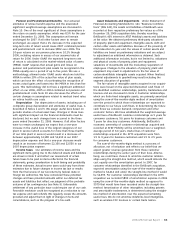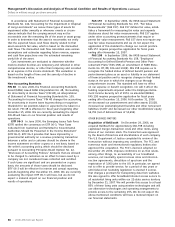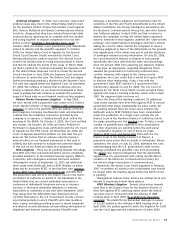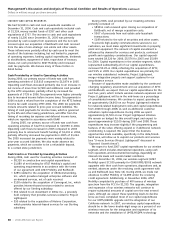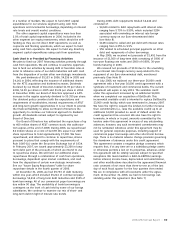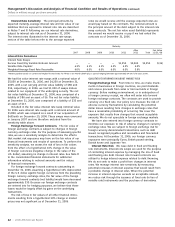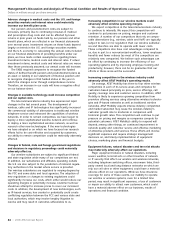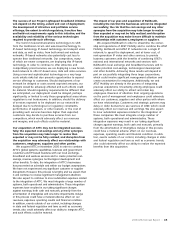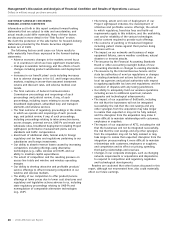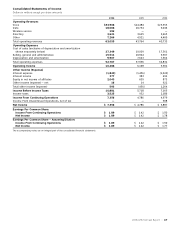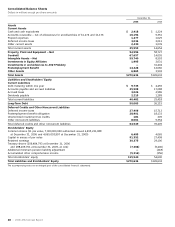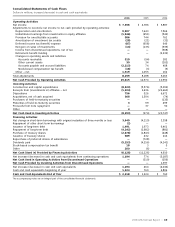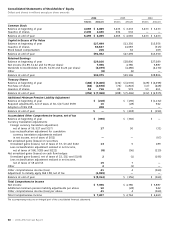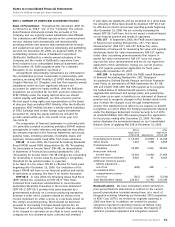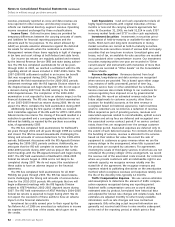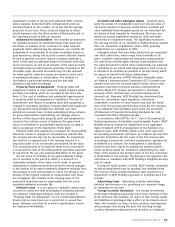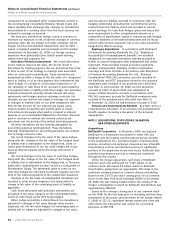AT&T Wireless 2006 Annual Report Download - page 47
Download and view the complete annual report
Please find page 47 of the 2006 AT&T Wireless annual report below. You can navigate through the pages in the report by either clicking on the pages listed below, or by using the keyword search tool below to find specific information within the annual report.
2006 AT&T Annual Report : :
45
The success of our Project Lightspeed broadband initiative
will depend on the timing, extent and cost of deployment;
the development of attractive and profitable service
offerings; the extent to which regulatory, franchise fees
and build-out requirements apply to this initiative; and the
availability and reliability of the various technologies
required to provide such offerings.
The trend in telecommunications technology is to shift
from the traditional circuit- and wire-based technology to
IP-based technology. IP-based technology can transport voice
and data, as well as video, from both wired and wireless
networks. IP-based networks also potentially cost less to
operate than traditional networks. Our competitors, many
of which are newer companies, are deploying this IP-based
technology. In order to continue to offer attractive and
competitively priced services, we are deploying a new broad-
band network to offer IP-based voice, data and video services.
Using a new and sophisticated technology on a very large
scale entails risks but also presents opportunities to expand
service offerings to customers. Should deployment of our
network be delayed or costs exceed expected amounts, our
margins would be adversely affected and such effects could
be material. Should regulatory requirements be different than
we anticipated, our deployment could be delayed, perhaps
significantly, or limited to only those geographical areas where
regulation is not burdensome. In addition, should the delivery
of services expected to be deployed on our network be
delayed due to technological or regulatory constraints,
performance of suppliers, or other reasons, or the cost of
providing such services becomes higher than expected,
customers may decide to purchase services from our
competitors, which would adversely affect our revenues
and margins, and such effects could be material.
Our acquisition of ATTC may not be integrated success-
fully; the expected cost-savings and any other synergies
from the acquisition may take longer to realize than
expected or may not be fully realized; and disruption from
the acquisition may adversely affect our relationships with
customers, employees, suppliers and other parties.
We acquired ATTC in November 2005 in order to combine
ATTC’s global systems capabilities, business and government
customers and IP-based business with our local exchange,
broadband and wireless services and to create potential cost-
savings, revenue synergies, technological development and
other benefits. To date, the integration of ATTC’s businesses
has proceeded on schedule and within our budget assumptions.
We have not experienced any significant customer or supplier
disruptions. However, this process is lengthy and we expect that
it will continue to involve significant management attention.
We also expect to continue to incur substantial expenses related
to the integration of ATTC. We must integrate a large number of
systems, both operational and administrative. These integration
expenses have resulted in our taking significant charges
against earnings, both cash and noncash, primarily from the
amortization of intangibles and one-time impairments. Delays
in this process could have a material adverse effect on our
revenues, expenses, operating results and financial condition.
In addition, events outside of our control, including changes
in state and federal regulation and laws as well as economic
trends, also could adversely affect our ability to integrate ATTC,
and such effects could be material.
The impact of our year-end acquisition of BellSouth,
including the risk that the businesses will not be integrated
successfully; the risk that the cost-savings and any other
synergies from the acquisition may take longer to realize
than expected or may not be fully realized; and disruption
from the acquisition may make it more difficult to maintain
relationships with customers, employees or suppliers.
We acquired BellSouth in order to streamline the owner-
ship and operations of AT&T Mobility and to combine the AT&T
Mobility, BellSouth and AT&T IP networks into a single IP
network; to speed the deployment, and at lower cost, of
next-generation IP video and other services; to provide
business customers with the benefits of combining AT&T’s
national and international networks and services with
BellSouth’s local exchange and broadband services; and to
create potential cost-savings, technological development
and other benefits. Achieving these results will depend in
part on successfully integrating three large corporations,
which could involve significant management attention and
create uncertainties for employees. Additionally, we and
AT&T Mobility are already in the process of integrating
previous acquisitions. Uncertainty among employees could
adversely affect our ability to attract and retain key
employees. Diversion of attention from ongoing operations
on the part of management and employees could adversely
affect our customers, suppliers and other parties with whom
we have relationships. Customers and strategic partners may
delay or defer decisions to use services of AT&T, which could
adversely affect our revenues and earnings. We also expect
to incur substantial expenses related to the integration of
these companies. We must integrate a large number of
systems, both operational and administrative. These
integration expenses may result in our taking significant
charges against earnings, both cash and noncash, primarily
from the amortization of intangibles. Delays in this process
could have a material adverse effect on our revenues,
expenses, operating results and financial condition. In addi-
tion, events outside of our control, including changes in state
and federal regulation and laws as well as economic trends,
also could adversely affect our ability to realize the expected
benefits from this acquisition.


